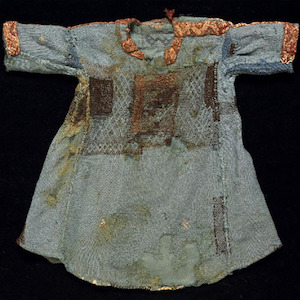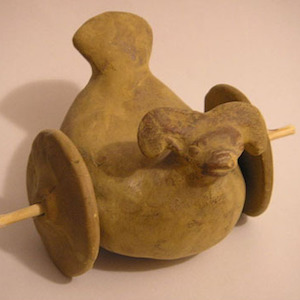Archaeology

Infant's Tunics
These two infant tunics, found south of Cairo by archaeologists, date to the period after the Arab conquest of Egypt.

Children's Tunics
These two children's tunics, found in Egypt by archaeologist Wm. Flinders Petrie, date to the Islamic period, 9th or 10th century. The blue tunic measures 45.5 cm long and 51 cm wide (18 x 20 inches).

Mud Crocodile Toy
This small sculpture of a crocodile is made of Nile River mud, and was probably a toy fashioned by a child at play. The crocodile was a familiar monster to children living along the Nile—an object of fear and fascination.

Phoenician Baby Bottle
The Phoenician terracotta vessel features a human face, the nose forming a narrow spout. The bottle is an archaeological find from Carthage, near modern Tunis, dated to 399 BCE-200 BCE. Archaeologists believe this object was a baby bottle.

Indus Valley Climbing Monkey Toy
The monkey figurine shown in two views is mounted on a wooden platform for display, but it was apparently designed with the ability to slide down a string or thin rod so as to appear to climb or jump.

Hariti Relief Panel at Candi Mendut, Java
The carved stone relief is from the interior of Candi Mendut, a Buddhist temple in Central Java. Mendut was built during the early Shailendra dynasty in about 824 CE. It may have been built on the site of a Hindu temple from a previous century.

Kuwera Relief Panel at Candi Mendut, Java
The carved stone relief is from the interior of Candi Mendut, a Buddhist temple in Central Java. Mendut was built during the early Shailendra dynasty in about 824 CE. It may have been built on the site of a Hindu temple from a previous century.

Indus Valley Wheeled Ram Toy
The hand-modeled, terracotta, wheeled figurine of a bird with a ram's head was excavated from an archaeological site in the Indus Valley called Mohenjo-daro, a city that flourished between 2600 and 1900 BCE.

Neolithic Baby Burial
This infant burial is from Çatalhöyük , a Neolithic settlement in Turkey that was occupied continuously for 2,500 years, between 8000 and 6400 BCE. The infant was between six months and one year old, and the burial demonstrates great care.

Sibling Burial
The two children whose skeletons are shown in this photograph were both under 10 years of age, and were probably buried at the same time. An earlier burial of a baby was found at a slightly lower level in the space between them.